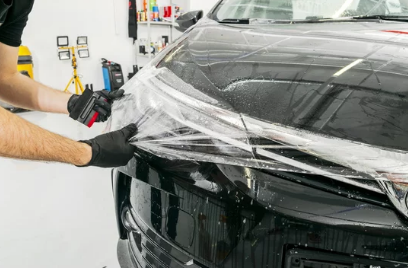Car ceramic coating and paint protection film (PPF) are both popular options for protecting a vehicle's paint job from scratches, chips, and UV damage. While both have their advantages, they are different products with different features and application methods. In this article, we'll take a closer look at the pros and cons of each, to help you decide which one is right for you and your vehicle.
Car ceramic coating, also known as ceramic paint protection, is a liquid coating that is applied to the surface of a vehicle's paint. The coating forms a chemical bond with the paint and hardens to create a protective barrier. This barrier repels water, dirt, and other contaminants, making it much easier to clean the vehicle. Additionally, ceramic coatings can also provide UV protection, which can help to prevent fading and discoloration of the paint.
One of the biggest advantages of car ceramic coatings is their durability. When applied correctly, a ceramic coating can last for several years, making it an excellent long-term investment. Ceramic coatings are also hydrophobic, meaning they repel water, which can make it easier to remove dirt, debris and grime from the surface of the vehicle. They also provide better resistance to scratches and chemical etching than traditional wax and sealants.
One of the downsides to ceramic coating is that it needs to be applied by a professional. This makes it more expensive than other types of paint protection, such as waxing or sealing. Moreover, the application process can be quite time-consuming, and it requires a certain level of expertise to be done correctly. Ceramic coatings are also not completely self-healing, and they may require a touch up over time to maintain the best level of protection.
Paint protection film (PPF), also known as clear bra, is a clear, self-adhesive film that is applied to the surface of a vehicle's paint. PPF is designed to protect the paint from scratches, chips, and other types of damage. It is also highly resistant to UV rays and can help to prevent fading and discoloration.
One of the biggest advantages of PPF is that it can be applied by a professional or as a DIY project. This makes it more affordable than ceramic coatings, and it can be done in a shorter amount of time. Additionally, PPF is self-healing and can fix minor scratches and swirl marks by itself.
One of the downsides to PPF is that it is not as durable as ceramic coatings. While a high-quality PPF can last for several years, it will eventually need to be replaced. Additionally, PPF can yellow over time and is not as easy to clean as a ceramic coated vehicle. It also doesn't offer the hydrophobic properties and chemical etching resistance as ceramic coating Singapore do.
In conclusion, both car ceramic coatings and paint protection film (PPF) are excellent options for protecting a vehicle's paint job. Ceramic coatings offer superior protection and durability, but are more expensive and need to be applied by a professional. On the other hand, PPF is more affordable and can be applied as a DIY project, but it is not as durable and doesn't offer the same level of protection as ceramic coatings. Ultimately, the choice between the two will depend on your budget and your specific needs. If you prioritize durability and superior protection, ceramic coating is the way to go. But if you are looking for an affordable solution that can be applied by yourself, then PPF might be a better option.


